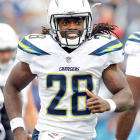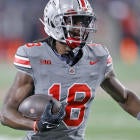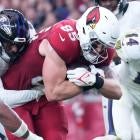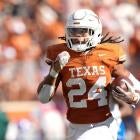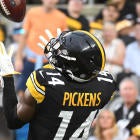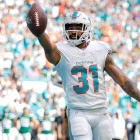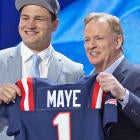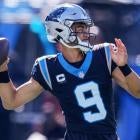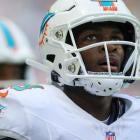Now that NFL free agency has settled down, with all of the big players having found new homes, we can review the impact on Fantasy leagues. That's what we did here with this 12-team non-PPR mock draft.
You can compare the results to our recent 12-team PPR mock draft, and it's interesting to evaluate the change in Fantasy value for players impacted by the recent NFL transactions. For example, DeAndre Hopkins is no longer a slam-dunk pick in Round 1 with his move from Houston to Arizona.
Here, Hopkins fell to Round 2 at No. 14 overall as the No. 5 receiver off the board behind Michael Thomas, Davante Adams, Tyreek Hill and Julio Jones. There were also eight running backs and Travis Kelce selected ahead of Hopkins, and I think this might be what happens in most non-PPR leagues.
Another member of the Cardinals, Kenyan Drake, went in Round 2 here at No. 22 overall, and he benefits with David Johnson no longer in Arizona. Johnson, meanwhile, went in Round 4 now that he's the new starter in Houston.
I didn't like that Johnson was drafted ahead of Melvin Gordon, Le'Veon Bell or James Conner, but Johnson has the chance for a bounce-back year as the lead running back for the Texans. I would prefer him in Round 5 in all leagues.
Round 4 is the right spot for Gordon now that he's in Denver, and Todd Gurley was drafted in Round 3. That's where you will likely see Gurley selected now that he's in Atlanta, although what the Falcons do in the NFL Draft at running back could change that -- if they make a move at all.
Stefon Diggs was another prominent player on the move with his trade from Minnesota to Buffalo, and he was drafted in Round 5. I think that's the right round for him since his Fantasy value is about the same with the Bills that it was with the Vikings -- a solid No. 2 receiver.
Some other players who saw their stock rise as a result of free agency include T.Y. Hilton (Round 4 with the addition of Philip Rivers at quarterback), Darrell Henderson (Round 5 with Gurley gone) and Ronald Jones (Round 5 with Tom Brady now in Tampa Bay and no competition in Tampa Bay's backfield). Kyler Murray also was drafted as the No. 5 quarterback now that he has Hopkins, and Josh Allen was the No. 6 quarterback off the board with the addition of Diggs. And Brady was the No. 11 quarterback drafted now that he's throwing to Chris Godwin and Mike Evans.
On the other hand, some players saw their stock decline following free agency, including Keenan Allen (Round 5 with Rivers gone), Phillip Lindsay (Round 6 with Gordon now in Denver) and Julian Edelman (Round 6 with Brady gone). And Deshaun Watson was the No. 7 quarterback drafted now that he's without Hopkins.
I drafted Lindsay, but it was out of necessity more than want. I started my team in this three-receiver league with Julio Jones at No. 11 overall, followed by Hopkins and then Cooper Kupp. I drafted Devin Singletary in Round 4, and I love this start.
But before my pick in Round 5, the running pool got extremely shallow. Henderson, David Montgomery, Damien Williams, Kerryon Johnson and Ronald Jones all went before me (I was hoping for Jones), and I was stuck.
Instead of panicking, I drafted the best-player available in Robert Woods as my flex, and my plan from that point on was to load up on running backs. It started with Lindsay in Round 6, Justin Jackson in Round 7, Tevin Coleman in Round 8, Latavius Murray in Round 9 and Tarik Cohen in Round 10.
With the way this team came together -- including Brady at quarterback, Noah Fant and Jack Doyle at tight end and Parris Campbell as a reserve receiver -- I like it. Lindsay can still be serviceable, even in tandem with Gordon, and Jackson gets a boost for the Chargers with Gordon gone as the running mate to Austin Ekeler. And Coleman, Murray and Cohen will still be significant contributors to their backfields this year.
You can compare my team to Dave Richard, who took an opposite approach by loading up on running backs over receivers. He drafted Derrick Henry, Josh Jacobs and Le'Veon Bell with three of his first four picks (he also took Patrick Mahomes in Round 3).
After drafting Mark Andrews in Round 5, Dave finally started getting some receivers with Jarvis Landry (Round 6), Darius Slayton (Round 7), Mike Williams (Round 8) and Diontae Johnson (Round 9). He also added Larry Fitzgerald in Round 13 and took a flier on Antonio Brown in Round 16.
We'll see which approach works better with the running backs vs. receivers, but I like my roster more since it's a three-receiver league, even in non-PPR. Maybe, by the time the season starts, Dave and I can make a trade to balance out our rosters.
In this league, all touchdowns are worth six points, and we award one point for every 10 yards rushing and receiving and one point for every 25 yards passing. We feature a starting lineup of QB, 2 RB, 3 WR, TE, FLEX (RB/WR/TE), K and DST. There also are six reserve spots for a 16-round draft.
Our draft order is as follows:
1. Ben Gretch, Fantasy Editor
2. R.J. White, NFL Editor
3. Andrew Baumhor, CBS Sports HQ Producer
4. Meron Berkson, CBS Sports HQ Producer
5. Chris Towers, Senior Editor, Fantasy
6. Dave Richard, Senior Fantasy Writer
7. George Maselli, Fantasy Editor
8. Will Brinson, Senior NFL Writer
9. Heath Cummings, Senior Fantasy Writer
10. Adam Aizer, Podcast Host
11. Jamey Eisenberg, Senior Fantasy Writer
12. Ben Schragger, Podcast Producer
| Round 1 | ||
|---|---|---|
| Pos | Team | Player |
| 1 | R.J. White | |
| 2 | Adam Aizer | |
| R.J. White | ||
|---|---|---|
| Rd | Pk | Player |
| 1 | 1 | |
| Adam Aizer | ||
| Rd | Pk | Player |
| 1 | 2 | |













